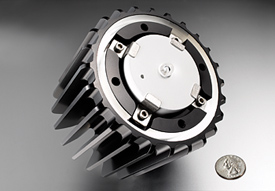Robe Launches Robin With Luxim's LIFI Lamps

Earlier this year there was a lot of excitement at the Prolight + Sound show in Frankfurt when Czech Republic company Robe revealed Robin, the first moving light to use the innovative LIFI plasma lamp from California-based Luxim Corp.
While the label 'plasma lamp' is being promoted by Robe to draw attention to their use of the LIFI lamp, it's likely to cause some confusion, because virtually every electric lamp that doesn't produce its light from a glowing filament, already involves the production of plasma.
Plasma is the most active state of matter. The solid form is the least energetic and, as a rule, the most stable state of matter; if you add sufficient energy to a solid it will usually melt into the liquid state. If you keep adding energy to the liquid form of a material, it generally vaporizes into the much more energetic gaseous state. When you add even more energy to the gaseous form of a material, it loses its grip on some of its electrons and becomes conductive plasma. The usual method for creating plasma is to put a pair of electrodes into a container of a gas, then pass a spark between them to energize the gas.
The metal-halide discharge lamps we use every day contain an inert gas, small amounts of mercury and the halide salts of metals. The inert gas is arced into conduction and its plasma form by a high-energy pulse being passed between the tungsten electrodes. This in turn heats the mercury and metal-halide salts until they become bright, light-emitting plasma.
THINGS TO CONSIDER
The requirement for electrodes in a lamp brings with it a range of problems. The high-energy start pulses cause some vaporization of the electrode material. This can lead to blackening of the transparent envelope of the lamp, which reduces its light output. As the electrodes erode from vaporization, the gap between them increases, necessitating a higher energy pulse to bridge the gap and start plasma production.
In addition, the electrodes also act as heatsinks, carrying away some of the energy from the lamp that might otherwise have been used to keep the plasma hot and glowing. Add to this the problems associated with getting electrical power through the envelope material and into the electrodes while not letting the high pressure gasses escape, and you have another set of places for degradation of lamp performance and eventual failure.
If you can create the plasma without needing electrodes, then you immediately increase both the operational life and the efficiency of the process. The idea of electrode-less plasma production has been around since demonstrations of the principle by Nikolai Tesla in the late nineteenth century.

Luxim LIFI plasma lamp A modern, high-output electrode-less lamp was developed in the early 1990s by Fusion Lighting. This now-abandoned technology used a cavity magnetron, similar to those found in domestic microwave ovens, to create plasma from powdered sulfur contained in a golf ball-sized quartz glass envelope.
While being very energy efficient—100 lm/W (lumens per watt)—the sulfur lamp had serious drawbacks. It was only available in very high output versions starting at about 150,000 lumens, which, while great for searchlights, doesn't have a lot of applications for general commercial, industrial or production lighting.
The sulfur lamp's other big problem was that it operated at 2.45 GHz—bang in the middle of the wireless spectrum used by everything from cordless phones and AV extenders to WiFi Ethernet—and it took a lot of work to stop all that Radio Frequency (RF) energy from leaking out into the environment.
TECHNOLOGY ADVANCES
Luxim's development of the technology they've released as LIFI is a progression from the sulfur lamp, in that it too uses RF energy to produce the plasma in its source, although in this case at 900 MHz, in the vicinity of mobile phones.
Luxim's lamp consists of a tic-tac-sized quartz glass envelope filled with an inert gas together with small amounts of mercury and a mix of metal-halide salts. The envelope is partially embedded in a puck of ceramic materials that contains the RF emitters, waveguides and feedback sensors to produce and control the excitation of the plasma. Unlike the sulfur lamp, the RF emissions from the LIFI are relatively easily manageable in the design of the reflector and fixture design process.
A critical component of the LIFI lamp is the electronics system that generates the RF energy and monitors the status of the lamp as it goes through start up and restrike sequences, and maintains the stability of the plasma column during continuous operation.
As a bonus, this control system allows the lamp to be very rapidly and smoothly dimmed between 20 percent and 100 percent of light output with little shift in color temperature between 100 percent and 50 percent.
The system also sports a serial data link that enables it to communicate with the outside world about everything from its health and operational status, to DMX and DALI control messages, and the state of the stock market. It can also be controlled by a 0–10 V analog control signal for compatibility with older control equipment. The LIFI-ENT-31-02 lamp used in the Robin can be restruck after only 40 seconds.
Lamp efficiencies in the LIFI range vary from 60 lm/W to around 120 lm/W, numbers that are increasing with each production model, as R&D continues to improve the control system, the RF coupling and the fill mix in the envelope.
Not only does the electrode-less design permit higher efficiencies, but it allows lamp life to extend to tens of thousands of hours before significant output reduction, and several times that before lamp failure.
The lamp used in the Robin has an efficiency of 67 lm/W and a life of 10,000 hours to 50 percent output. That's a little over three years and four months if run for eight hours every single day.
The Color Rendering Index (CRI) of the LIFI lamps range from a reasonable 80 to an impressive 96, depending on the gas fill and the usual trade-off between efficiency and CRI.
As with the CRI, the correlated color temperature of a LIFI lamp depends on the mix of materials used in the gas fill, with current products ranging from 5300 K to 9000 K. The LIFI-ENT-31-02 lamp used in the Robin has a color temperature of 5300 K and a CRI of 94. The color temperature change for this lamp is a fairly gentle increase (blue shift) of approximately 0.08 K per hour, or 800 K during its very long life.
This is sufficiently significant to require periodic color temperature corrections where the output is being used for photographic or video applications or where there are lamps of radically different ages in the rig. According to Luxim's engineers, it is possible to adjust the color temperature of a LIFI lamp by a few hundred Kelvin, through modifying the amplitude of the RF excitation via the lamp's data link.
A LONG LIFE
Lamp replacement for a LIFI system requires changing out the complete ceramic puck, quartz envelope and heatsink package every 10,000 hours, a process no more difficult than changing a conventional lamp. The electronics package, which can also be replaced, has a designed life expectancy of 60,000 hours, which corresponds to nearly six-and-a-half years of operation.
Being on a much smaller scale than the sulfur version, the LIFI lamps produce light in quantities that are useful for commercial, street lighting and architectural purposes, including some lower-end projection and entertainment applications. Luxim's first commercial products a couple of years ago were in the 170-watt region, but its current offerings are in the vicinity of 266 W, with outputs set to increase in future products to an impressive 1 kW. All current LIFI lamps are designed to operate from a 28 V DC power supply, with future designs moving to the more widely used 24 V and 48 V DC. The lamp used in the Robin 3 Plasma spot has a light output equivalent to a 400 W metal-halide lamp.
The Luxim LIFI lamp fills a need for a compact, long-life, high-efficiency, high-CRI light source at a density, light output and efficiency that may never be met by LEDs.
According to Apurba Pradhan, Luxim's senior technical marketing engineer: "Entertainment and architectural lighting are natural next steps; especially those fixtures that need great color and tight narrow beams. Then beyond that, we plan to tackle the general lighting space by offering energy efficiency, robustness, high color rendering, and controls features."
Electrode-less plasma discharge technology deserves a top position on your list of technologies to watch.
Andy Ciddor has been involved in lighting for more than three decades as a practitioner, teacher and writer. You can reach him via e-mail c/o TV Technology.
The professional video industry's #1 source for news, trends and product and tech information. Sign up below.
